by Beata Furstenberg
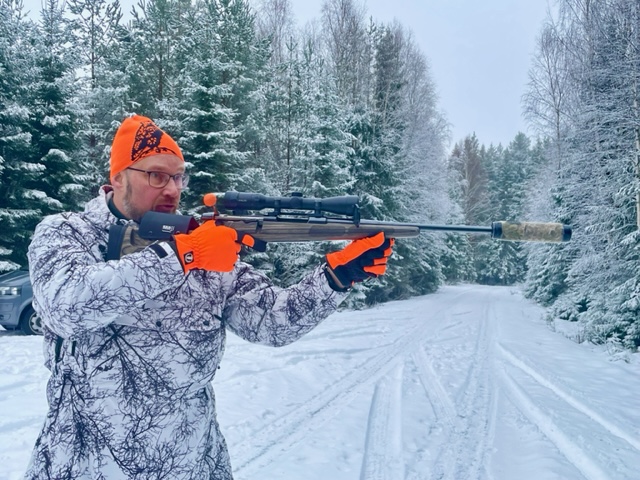
A wolf hunter on this year’s hunt in Sweden, where three times as many wolves were killed.
New laws and regulations in Sweden have given Hunting Associations more decision-making power over wildlife management, leading to an explosion of predators killed and setting Sweden up to become a trophy hunters paradise.
Unlike other European countries where the wildlife management is governed by a State Department, Sweden has delegated its wildlife management to Hunting Associations. Making it very easy for foreign hunters to hunt in Sweden, as the Hunting Associations’ influence continues to grow in Parliament.
“It is completely incomprehensible the way Sweden manages its wildlife” states Robert Franzen, who worked thirty-five years at the Environmental Protection Agency (EPA), the government department responsible for wildlife management. Franzen points out “Sweden has not implemented the EU Directive and with the government change last year, they have closed the Department which was supposed to oversee it.”
The wolf, lynx, and bear are classified as endangered species and protected according to the EU Habitat Directive, making it illegal to hunt or kill these species. Sweden claims “an exception to the rule”- which conservationist do not believe is a valid claim and they have asked EU to step in and take Sweden to Court.
“We are witnessing an unprecedented slaughter of Swedish animals- for no valid reason at all except for hunters wanting to kill them as trophies” states Marie Stiegard-Lind, Vice President of The Association of Hunting Critics, an organisation for the conservation of large predators.
The EPA claims that endangered species are “protected and hunted in a way that is strictly controlled”. This is contradictory to the large number of animals killed- such as the 624 bears shot last year- twice as many as five years ago.
“They slaughter whole bear families and it is horrifying” states Stiegard-Lind.
Conservationist and Wildlife Protection Associations- such as The Association of Hunting Critics, The Predator Preservation Association, World Wildlife Fund (WWF)- have pleaded with EU to stop the hunting of endangered species which Sweden is actively pursuing. In the meantime, the killing continues with the bear hunt set to start in August.
“It should not be possible to buy hunting trips for animals that are protected in the EU Directive- but you can in Sweden” states Franzen.
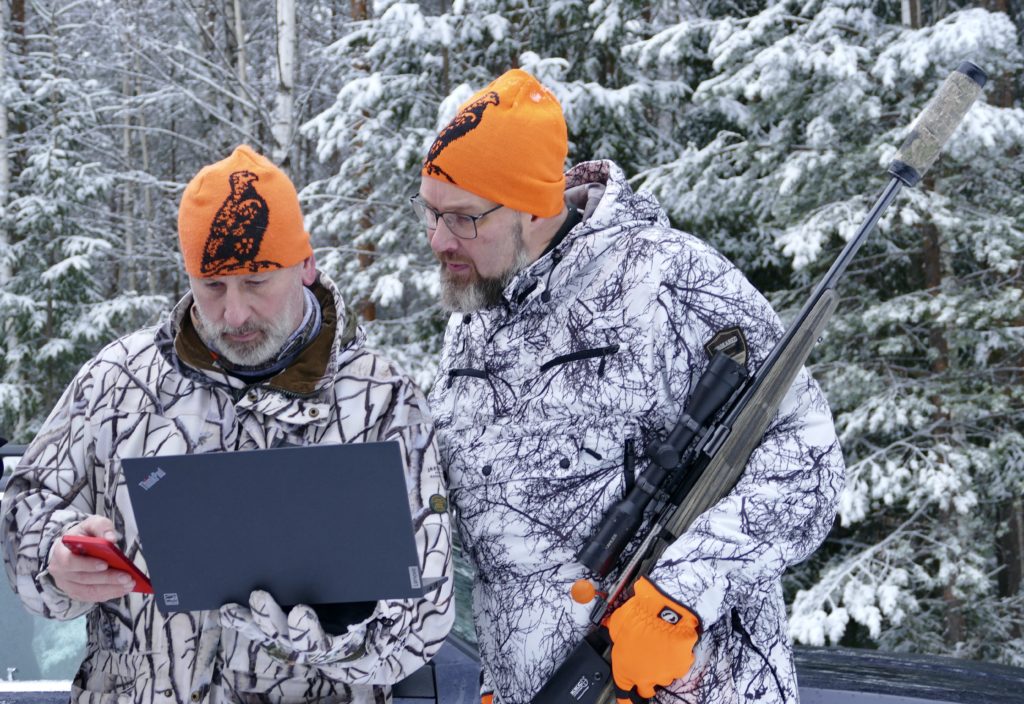
Record breaking wolf and lynx hunts
This year two record-breaking hunts have already taken place. In January, 75 wolves were killed compared to the 27 last year- an increase of three times the numbers.
In March, 201 lynx were killed compared to 88 last year- an increase of two and a half times the numbers.
In the last six years, the number of bears allowed to be hunted in what is called “licensjakt” has doubled from 324 to 624 animals. The bear hunt is set to start August 21st, with the announcement of how many are allowed to be killed at the end of June. “We expect the numbers to be about the same as last year” states Per Risberg, who is responsible for bears at the EPA.
In addition to the “licensjakt” there will be permits issued for “skyddsjakt” which is “protective hunting”. This permit is supposed to be granted on rare occasions when a single predator is threatening a farmer or their domesticated animals. In Sweden, protective hunting permits are issued in the hundreds for various species.
“It is incredible how many ‘protective hunting’ permits are issued per year” states Franzen.
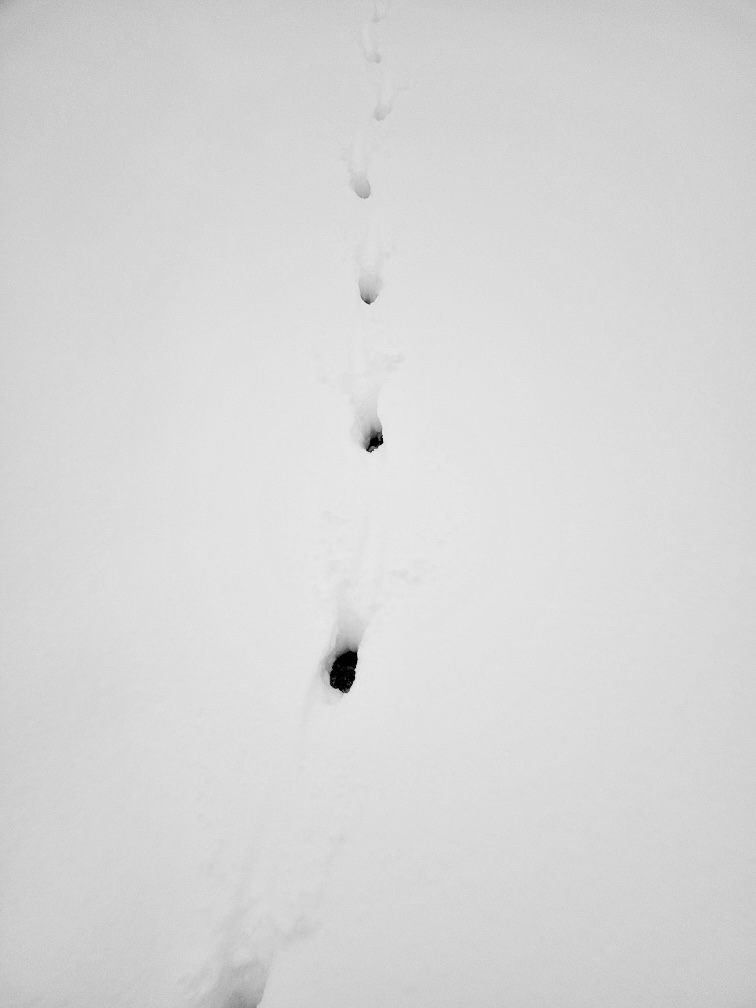

Wolf tracks in the snow and a hunter heading into the woods. Picture by Beata Furstenberg.
The Hunters are in Control
In November of 2022 a new law was added to the current Hunting laws in Sweden giving the Hunting Associations more power to oversee the management of large predators. They were given a three-year assignment (previously it had only been one year) in order to “give continuity” of decision-making. They were given 43,3 million crowns to help “manage wildlife” and keep “a balance between humans and predators through protective hunting”.
In addition, the Hunting Associations proposed the creation of a new ‘State Department for Wildlife Management’- which they suggested would completely be run by the Hunting Associations-not the government. The bid was rejected by the government but the Hunting Associations have vowed to continue their lobbying efforts in the future.
Franzen says it is hard to follow how predators are managed in Sweden because it is delegated to several different departments, local county governments (“Länstyrelesen”), and different rules apply to different species. For example, you have to register in order to hunt wolf, lynx and wolverine on the EPA’s website- but not if you are going to hunt bear.
Yet, the EPA website proclaims that bear is “protected and hunted in a way that is strictly controlled”.
When we asked Risberg- how the EPA can claim that bear hunting is “strictly controlled” when you do not have to register for bear hunting at all- he answers “Well, we know at the end of the hunt how many bears were shot”.
Are the numbers accurate?
The EPA claims that there are just as many bears today as six years ago (2017) when the last official inventory was taken of 2877 bears. According to the EPA, Sweden has 2900 bears today even though several hundred have been killed during the last few years.
For the EPA claims to be accurate, the bears would have to have reproduced at a higher rate than the numbers that were killed. “The bear is the animal which has the slowest reproduction rate of all our animals in Sweden” states Stiegard- Lind.
The “Bear project” is an ongoing research project between Sweden and Norway and Dr. Jonas Kindberg, a Swedish bear researcher and scientist, is head of the project. Prior to working on the Bear project, he worked 13 years for the Hunting Associations.
Kindberg is responsible for advising the EPA on the bear population size each year and it is these numbers that the EPA will base their hunting quotas on. Asked whether the Swedish bear population ‘is as large as the EPA claims’, Kindberg answers “It is hard to know exactly- because we don’t know the precise number- but we compare different methods and check if they come to the same conclusion and results”. However, he believes the numbers are “highly accurate”.
Inventory is done through DNA analysis of droppings and a secondary program called “Bearops”- where sightings of bears are reported and registered. He states “We have developed different methods including the observations of hunters as they start the moose hunt”. However, he admits that “all methods have a margin of error of course”.
The people responsible for collecting bear droppings and reporting the sightings (“Bearops”)- are hunters.
Hunting numbers per year by Beata FurstenbergSource: Environmental Protection Agency (EPA)
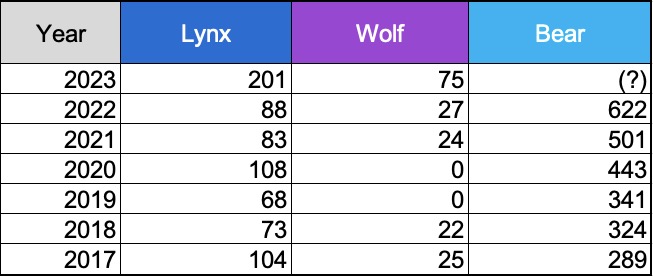
Source: Environmental Protection Agency (EPA)
Unlike other European countries Wildlife management
Why does the management of Swedish wildlife not fall to an un-biased-official-government department that does not take advise from the hunters – who like to hunt animals?
In Norway, the Department of Nature Management, is responsible for large predators and is separate from any hunting organizations.
In Denmark, wildlife management is also done by a department called The Environmental Protection Agency (EPA). However, it is not tied to any Hunting Associations and hunting is strictly controlled. If you wish to apply for a hunting license it will take four weeks for the review of your application. If you are a foreign hunter then the EPA will ask the Police Department to run a background check before granting or denying the permit.
In Finland, The Ministry of Agriculture and Forestry is responsible for large carnivores and they make it clear on their website how important the EU Habitat Directive is for Finland’s wildlife management. For example, this January hunters wanted to get permits to kill 18 wolves but the highest court in Finland ruled that it was against the EU Directive and therefore denied their request. At the same time in Sweden, the largest-ever wolf hunt was taking place with permits for 75 wolves.
In contrast to members states, the Parliament Building in Stockholm has a shooting range in its basement. Franzen, who has worked with member states during his time at the EPA points out that “In Norway this would be inconceivable”.
The Swedish Hunting Associations are deeply connected to members of parliament and it is no secret that many politicians themselves are hunters. “One could argue that this makes it hard to be objective about wildlife management” states Stiegard-Lind.
Magnus Orrebrant, President of The Predator Preservation Association, who works closely with Stiegard-Lind’s organisation, points out “Who is paying for the shooting range? Is it the taxpayers? Is that ethical? Do they even have a gym?”
The following video is a preview of a wolf documentary that is currently shooting in Sweden by journalists Martijn Kramer and Jitse de Graaf from the University of Utrecht, Netherlands. Here politician, Kjell Arne Ottosson talks about how politicians practice at the shooting range during lunch or when they have free time.
Who is responsible for the overall wildlife management?
Sweden’s hunting quotas are set by local regional government offices. Franzen points out that overall wildlife management is not considered on a State level, as a whole. It is fragmented and split into pieces.
“The wildlife does not belong to the State- as it does in almost every other country in the world” he explains. “This is quite remarkable- because then the individual landowner has the ownership rights to the animals. And the landowner can sell the ‘hunting right’ on his land to other people- there is a lot of money to be made in hunting”.
This system makes trophy hunting in Sweden extremely easy- and very beneficial to landowners- according to Franzen.
Trophy Paradise
Sweden offers a lot of legal hunting opportunities and makes it easy for hunters. Anyone can hunt bear- you (as a foreigner) only have to be in the company of “a friend” who has a valid hunting card in Sweden. The hunting card is 400 crowns. This makes it easy for Swedish organizers to arrange hunting trips for foreigners.
And since the animals were shot legally, it makes the exportation of the animal skin easy, explains Orrebrant. Trophy hunting requires Convention of International Endangered Species (CITES) paperwork which is granted if the animal is shot legally.
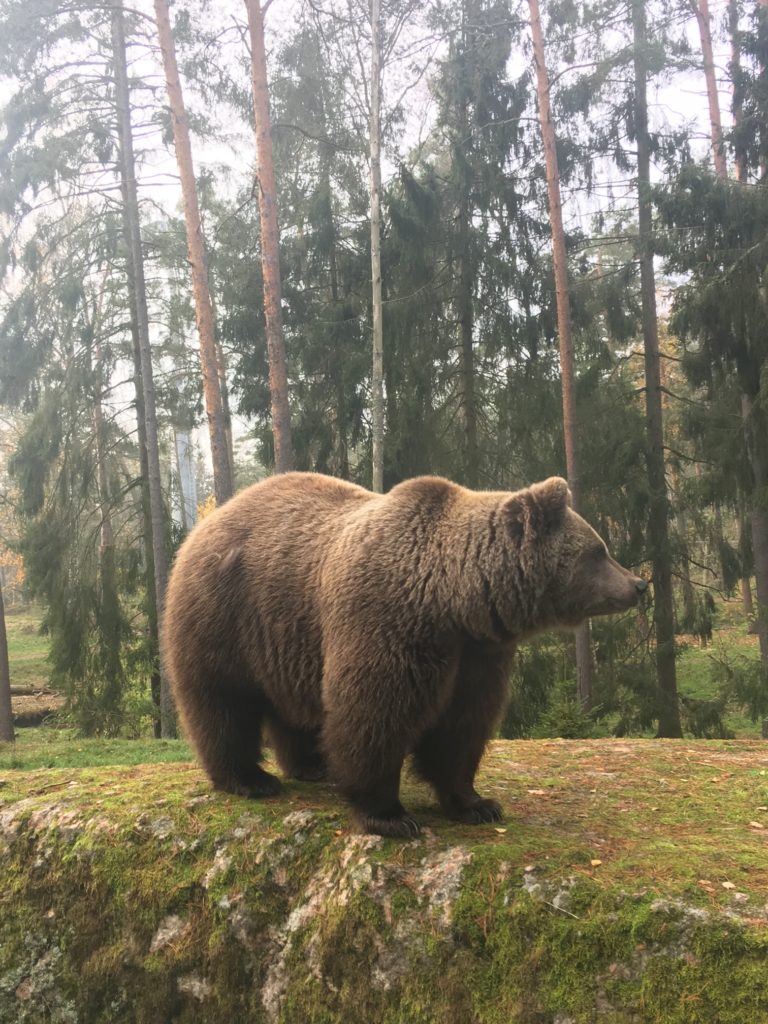

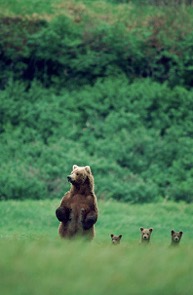
Swedish brown bears at Kolmårdens Zoo. Pictures taken by wildlife and predator expert Sunna Ekberg. Last image is copyrighted by Gettyimages.
What is the solution needed?
Stiegard-Lind hopes that EU Commission will take Sweden to court and deem the hunting of wolves illegal because she believes it would have a cascading effect on the other species that are overhunted. “We believe that it is absolutely necessary for the EU Commission to take Sweden to Court because it is very hard for us, smaller organizations, and even the larger ones, to reverse Sweden’s predatory policy because the hunting associations are very powerful in their lobbying activities and have strong contacts to political powers of our Parliament- there are several Ministers who are hunters, that doesn’t really help”.
Wildlife conservationists and activists are saying the number of large predators killed in Sweden is out of all proportion to the danger posed to livestock and are pushing the EU to take action against Sweden for breaching the Habitat Directive.
Benny Gavfert of the World Wildlife Fund (WWF) states “We are working judicially, and we have informed the EU Commission to address these issues with the Swedish government because they have invoked an exception of Article 16 in the Habitats Directive. We strongly question the basis for their claims”.
He adds “The hunters have their own interests at heart which means they can spread information- and angle their arguments- to their own benefit”.
The wolf question is hotly debated in Parliament each year…this video is from a 2022 debate…
Created by Beata Furstenberg
